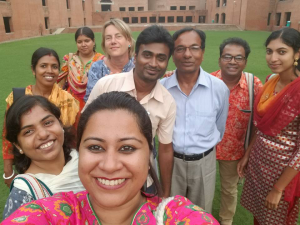Match making
Match making
The Bangladesh country team has chosen 3 solutions in India for the learning exchange, namely: READ Centre, Honey Bee Network's Business Development Micro Venture, and Barefoot College. Based on these solutions they have assessed which peers and stakeholders are needed to form the learning group.
So who do you choose for your learning group?

- Jolly Nur Hague, project lead Oxfam Bangladesh
- Toma Rani Saha, jr project lead Oxfam Bangladesh
- Puspita Saha, MEAL officer Oxfam Bangladesh
- Lokman Hossain, project leader from local partner
- Kamona Roy, project leader from local partner
- Manaranjan Mandal, district chair men
- Lasmi Halder, local business women
- Dulali Bakchi, female youngster from the local community
- Suman Golder, men youngster from the local community
- Nimesh Ghimire, rural enterprise expert and social innovator from Nepal
- Carin Boersma, global learning expert from Oxfam Novib in the Netherlands
Please fill in this form to evaluate the adequacy of your learning group
These are your results
Learning group composition
Below you can see the outcome based on your previous answers. The results explain which type of roles are already represented in your current learning group, and which other complimentary roles may still be missing at this point.
The following profiles are not included in your group:
Gender
- 70%
- 30%
With a view to changing societal conditions and causing deep changes in power structures, while promoting a richer composition of the group in views and diversity, a 40%-60% gender balance in the group composition is recommended.
Cultural and religious awareness
You have established the following items as things to keep into account:
During the exchange, there may be cultural differences or religious issues that should be taken into account when selecting the dates for the exchange. Diversity in the composition of the learning group, whereas in relation to culture, professional background and/or experience, influences positively the learning process.
Language
Of your group speak fluently the language of exchange that is .
30%
To guarantee successful learning, any language barriers should be addressed beforehand. If there are people within the group who have any type of difficulties understanding the language of the exchange, these should be assessed and solved jointly before the exchange takes place. At least 70% of the participants should speak and understand the language of the exchange. If this isn’t possible, it is strongly advised that you make sure some sort of translation is available.
To guarantee successful learning, any language barriers should be addressed beforehand. If there are people within the group who have any type of difficulties understanding the language of the exchange, these should be assessed and solved jointly before the exchange.
Local Communities
Eco System.
30%
Getting to know the local realities is an asset if you want to fully test, transform and implement the methodology after the exchange is over. To guarantee successful testing, transforming and implementation of the learning outcomes after the exchange, it is recommended that at least 50% of the members of the group are part of the local communities or key actors in the local eco system.
Ensure that at least 50% of the members of the group are part of the local communities or key actors in the local eco system. This is key for successful testing, transforming and implementation of the methodology.
General recommendations
There are no strict rules on how a learning group should be composed. This depends on the local context, the objectives of the learning group, the strategy for the group to make a change, etc. However, our previous experience in E-Motive and in our evaluation reports shows that the following are good practices to be kept in mind when configuring a successful learning group, as these can help mitigate and manage any risks and make the most of the opportunities in the learning process.
Sustainability
For E-Motive to reach success, it is important that the learning is implemented in practices and translated into policies. In most cases and according to previous experiences, sustainable change has been guaranteed by a combination of factors.
- Make sure that resources are available in order to test knowledge and learning in the local context after the exchange has concluded. Ask group participants to fill in a profile with motivation and proposed actions after the exchange, to make sure you have the best group composition. Bring in actors in the group with powerful resources and network connections.
- In the learning group, you need reliable role models from local communities to focus on opening mind sets. In addition, you need influencing actors such as religious leaders, local authorities, and others who could give support in changing practices and policies.
- Community engagement is key. We recommend organizing community dialogues after the exchange has taken place so as to share the learning outcomes and experiences. Use local and social media. Bring key actors in the group from the community, local market and government to guarantee engagement and access to local resources for sustainability.
- E-motive focuses on changing the way people do things, the way they approach and the way they think about problems. Therefore, you need networkers to gain support and help develop spin-offs and you need to connect to advocacy actors to set up a strategy for influencing mind sets and agendas.
Below you’ll find the outcome of the questionnaire. Based on this, you may want to consider adjustments to your participant list. Alternatively, you could look for other options to connect to the less represented roles either before or after the actual exchange.
Role name
TEXTO A: Lorem ipsum dolor sit amet, consectetur adipiscing elit. Nulla varius risus at est pellentesque, nec vestibulum orci euismod. Vivamus luctus pellentesque metus, sit amet consectetur sem pellentesque eu.
TEXTO B: Lorem ipsum dolor sit amet, consectetur adipiscing elit. Nulla varius risus at est pellentesque, nec vestibulum orci euismod. Vivamus luctus pellentesque metus, sit amet consectetur sem pellentesque eu.
